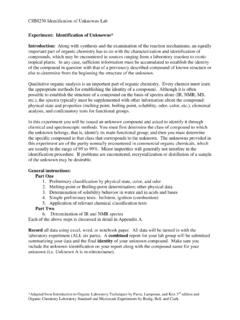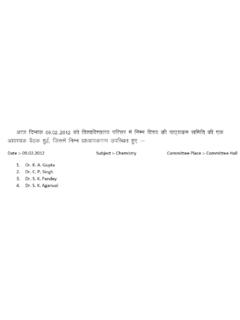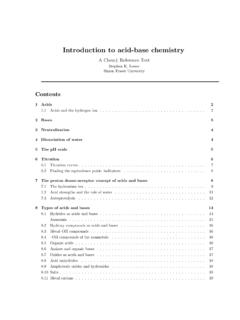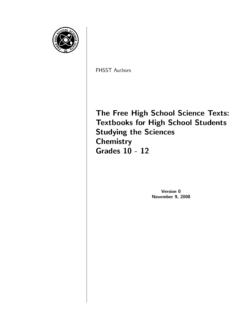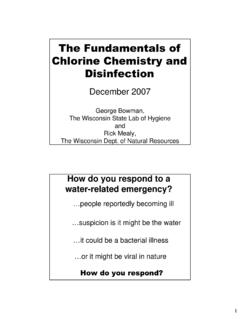Transcription of An Introduction to Organic Chemistry
1 81 An Introduction to Organic Chemistry An Introduction to Organic Chemistry 82 Organic Chemistry Organic Chemistry is the study of compounds containing carbon with the exception of simple compounds carbonates (CO32-), carbon dioxide (CO2) and carbon monoxide (CO). Nomenclature There are over 6 million known Organic compounds. Nomenclature is therefore very important. Here are some basic guidelines that should help in the naming of the simple compounds you will come across during this course.
2 You will get practice at this in your tutorials. 1) Find the longest carbon chain in the molecule. This will give you the base of the name: No of C atoms Name 1 meth-ane 2 eth-ane 3 prop-ane 4 but-ane 5 pent-ane 6 hex-ane 7 hept-ane 8 oct-ane 9 non-ane 10 dec-ane An Introduction to Organic Chemistry 83 2) Determine the principle functional group and its position. principal functional group formula ending becomes alkane C-C -ane alkene C=C -ene alkyne C C -yne alcohol -OH -anol aldehyde -CH=O -anal ketone >C=O -anone carboxylic acid -COOH -anoic acid Position is indicated, where necessary, by numbering the carbons in the main chain.
3 Position need not be indicated for alkanes, as they have no functional group, and aldehydes and acids, as they are terminal functional groups. Positioning numbers are flanked by dash signs. Multiple positions for a given functional group are separated by commas and indicated by the prefixes di, tri, tetra, penta, hexa, hepta, octa , nona and deca. 3) Ancilliary functional groups are given in alphabetical order, with their position at the beginning of the name. ancilliary functional group formula prefix methyl -CH3 methyl ethyl -C2H5 ethyl An Introduction to Organic Chemistry 84 propyl -C3H7 propyl butyl -C4H9 butyl pentyl -C5H11 pentyl hexyl -C6H13 hexyl heptyl -C7H15 heptyl octyl -C8H17 octyl nonyl -C9H19 nonyl decyl -C10H21 decyl fluorine -F fluoro chlorine -Cl chloro bromine -Br bromo iodine -I iodo amine -NH2 amino hydroxyl -OH hydroxy cyanide -CN cyano benzyl -CH2C6H5 benzyl phenyl -C6H5 phenyl Empirical and Molecular Formulae Quantitative elemental analysis
4 Tells us what elements make up a compound and in what proportions. The percentage of each element present in a compound is determined by total combustion. C, H, S and N burn to give CO2, H2O, SO2 and NO2. The quantities of these gases may readily be measured and this leads to information that can be used to calculate the % composition and hence empirical and molecular formulae. An Introduction to Organic Chemistry 85 How is this done? First some definitions: One mole of a substance is x 1023 particles of that substance.
5 This huge value is termed Avogadro s number. One mole of any substance has a mass equal to the relative molecular mass (RMM) of that substance in grams. Relative molecular mass is the sum of the relative atomic masses (RAMs) of the constituent elements in the compound. for ethanol C2H5OH RMM = (2 x g mol-1) + (6 x g mol-1) + ( g mol-1) = g mol-1 g of an Organic compound X containing only C, H and O produces: g of CO2 g of H2O upon total combustion. Calculate the empirical formula of the compound X.
6 Consider the CO2 CO2 RMM = g mol-1 + 2 x g mol-1 = g mol-1 g of CO2 = g / g mol-1 = x 10-3 mol x 10-3 mol of CO2 were produced from x 10-3 mol of C The mass of C = x 10-3 mol x g mol-1 = g % C in X = 100% x g / g = An Introduction to Organic Chemistry 86 Consider the H2O H2O RMM = 2 x g mol-1 + g mol-1 = g mol-1 g of H2O = g / g mol-1 = x 10-3 mol x 10-3 mol of H2O were produced from x 10-2 mol of H The mass of C = x 10-2 mol x g mol-1 = g % C in X = 100% x g / g = Consider the O % O in X = 100% - - = Mass % are used to calculate mole % which yield the empirical formula or simplest ratio of the elements present.
7 C H O relative mass % divide by RAM mole % divide by smallest1 2 1 This gives the ratio 1:2:1 and the empirical formula CH2O. The molecular formula could be any multiple of the empirical formula C2H4O2, or C3H6O3 since these would all have the same percentage mass ratios. x 10-3 mol of C means x 10-3 mol of X in g RMM of X = g / x 10-3 g mol-1 = g mol-1 The molecular formula is also CH2O and X is actually methanal or formaldehyde. An Introduction to Organic Chemistry 87 Structural and Isomerism Structural Formulae Different arrangements of atoms for a given molecular formula are often possible.
8 Such compounds are called isomers. Example one: C4H10 CH3CH2CH2CH3 CH3 CHCH3CH3 CCCCHHHHHHHHHH CCCHCHHHHHHHHH An Introduction to Organic Chemistry 88 Example two: C2H6O CH3CH2OH CH3 OCH3 CCOHHHHHH COCHHHHHH OH O Both exemplify structural isomerism. C4H10 is a molecular formula as it shows constituent atoms. CH3HC2CH2CH3 is a structural formula as it shows constituent atoms AND connectivities. Stereoisomerism It is also possible to arrange the atoms in molecules with the same structural formulae such that they have different spatial orientation.
9 This is known as stereoisomerism. There are two distinct types of stereoisomer: geometric and optical. An Introduction to Organic Chemistry 89 Geometric isomerism It is possible for single C-C bonds to rotate freely, however, double C=C bonds cannot. Thus if the two carbon atoms of a C=C bond carry different groups, it becomes possible to orientate these groups in two ways to create geometric isomers. HCOOHHCOOH HHCOOHHOOC cis-isomer trans-isomer Z ( Zusammen - together) E ( Entgegen - opposite) Geometric isomers have different physical and chemical properties An Introduction to Organic Chemistry 90 Optical isomerism A carbon atom attached to four different groups (substituents) is termed a chiral centre.
10 Two different non-superimposable mirror images are possible. These mirror images are called enantiomers. Enantiomers have identical physical properties, except for the direction in which they rotate the plane of plane polarised light. Rotation to right termed dextro or d Rotation to left termed laevo or l They have identical chemical properties except towards optically active reagents. An Introduction to Organic Chemistry 91 If a compound contains a chiral centre but does not rotate the plane of plane polarised light then it must be an equal mixture of d- and l-enantiomers.
